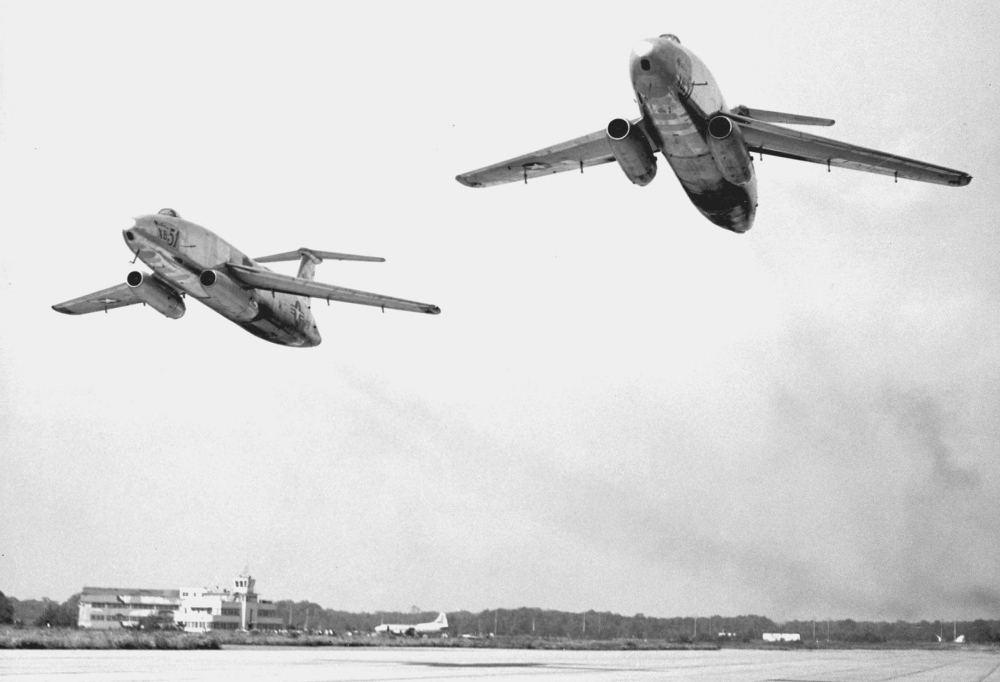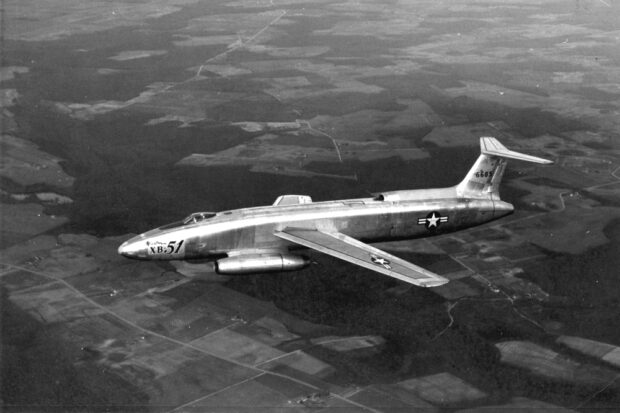The Martin XB-51 was a colossal bomber aircraft built in the late 1940s that exceeded all expectations and was probably the finest bomber that never went to battle. The XB-51’s lifespan was too brief to be awarded an official nickname. Still, its unusually prolonged shape granted it the moniker of “The Flying Cigar.”
Faster than almost any fighter of its time, military experts believe the Martin XB-51 could have made a substantial difference in the Southeast Asian wars, but it was never produced. Defense analyst Robert Dorr wrote in the Defence Media Network:
“The XB-51 incorporated a rotary weapons bay that enabled it to deliver bombs while flying at high speed. Capable of 645 mph at sea level in level flight, the XB-51 would have been able to run away from most fighters of its era.”
Despite successful trial runs and a promising future, the B-51 project was ultimately canceled for mysterious political reasons…
The Martin XB-51 was an American trijet ground-attack aircraft.
It was designed in 1945 and made its maiden flight in 1949. It was originally designed as a bomber for the United States Army Air Forces under specification V-8237-1 and was designated XA-45. The “A” ground-attack classification was eliminated the next year, and the XB-51 designation was assigned instead. The requirement was for low-level bombing and close support. The XB-51 lost out in evaluation to the English Electric Canberra which – built by Martin – entered service as the Martin B-57 Canberra.
Design and development
This unorthodox design, first flying on 28 October 1949, was fitted with three General Electric J47 engines – an unusual number for a combat aircraft – two underneath the forward fuselage in pods, and one at the extreme tail with the intake at the base of the tailfin. The innovative, variable incidence wings, swept at 35° and with 6° anhedral, were equipped with leading edge slats and full-width flaps. Spoilers gave most of the roll control and undersized ailerons provided feel for the pilot. The combination of variable incidence and slotted flaps gave a shorter takeoff run.[3] Four 954 lb (4.24 kN) thrust Rocket-Assisted Take Off (RATO) bottles with a 14-second burn duration could be fitted to the rear fuselage to improve takeoff performance. Spectacular launches were a feature of later test flight
The main landing gear consisted of dual wheel sets in tandem in the fuselage, similar to the Boeing B-47 Stratojet, with outrigger wheels at the wingtips (originally proved on a modified Martin B-26 Marauder named “Middle River Stump Jumper”). The XB-51 was a large but aerodynamically “clean” design which incorporated nearly all major systems internally. The aircraft was fitted with a rotating bomb bay, a Martin trademark; bombs could also be carried externally up to a maximum load of 10,400 lb (4,700 kg), although the specified basic mission required only a 4,000 lb (1,814 kg) bomb load. Eight 20 mm cannon mounted in the nose would have been installed in production aircraft.
Crew was a pilot under a “fighter”-type bubble canopy and a Short-range navigation and bombing system (SHORAN) operator/navigator in a compartment located lower than and to the rear of the cockpit (only a small observation window was provided). Both crew members were provided with a pressurized, air conditioned environment, equipped with upward-firing ejection seats. The XB-51 was the first Martin aircraft equipped with ejection seats, these being of their own design.

Martin’s two XB-51 prototypes, seen low over the runway on a high-speed pass
Operational history
In 1950, the United States Air Force issued a new requirement based on early Korean war experience for a night intruder/bomber to replace the Douglas A-26 Invader. The XB-51 was entered, as well as the Avro Canada CF-100 and English Electric Canberra; the XB-51 and Canberra emerged from these as the favourites.
Test flights showed the XB-51 to be highly maneuverable at low altitudes and substantially faster than the Canberra and faster than most fighter aircraft of the era. However, the XB-51’s endurance was significantly lower than that of the Canberra and this factor was decisive in its cancellation. In addition, a load limiting factor of only 3.67 g (36 m/s2) meant that the general strength of the airframe was relatively low and would prevent tight turns while fully loaded. Additionally, the tandem main gear plus outriggers of the XB-51 were thought unsuitable for the requirement to fly from emergency forward airfields.
While the XB-51 was not selected for procurement, it was decided that Martin would build 250 Canberras under license, under the designation B-57. Furthermore, Martin’s rotating bomb bay would be incorporated into production variants of the B-57. A “Super Canberra”, incorporating other XB-51 features, such as swept wings and tail-planes, was also proposed. This aircraft – although it promised much better speed and performance than the B-57 – never reached the prototype stage, mainly because the many changes would have taken too long to implement and test, before it could be put into production.
Flights by the XB-51 prototype, 46-685, continued, for general research purposes, following the project’s official cancellation by the USAF. A second prototype, 46-686, which first flew in 1950, crashed during low-level aerobatics on 9 May 1952, killing pilot Major Neil H. Lathrop. 46-685 continued to fly, including an appearance in the film Toward the Unknown as the “Gilbert XF-120” fighter. The surviving prototype was en- route to Eglin AFB to shoot additional footage when it crashed during takeoff, following a refuelling stop in El Paso, Texas, on 25 March 1956.
Top Photo: First prototype, 46-685 during testing
Surce: YouTube: Wikipedia

